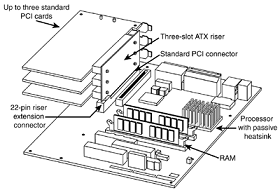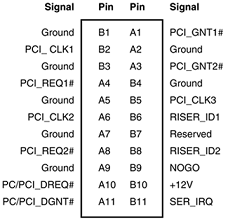ATX Riser
In December 1999, Intel introduced a riser card design modification for ATX motherboards. The design includes the addition of a 22-pin (2x11) connector to one of the PCI slots on the motherboard, along with a two- or three-slot riser card that plugs in. The riser enables two or three PCI cards to be installed, but it does not support AGP.
ATX motherboards typically are found in vertically oriented tower-type cases, but often a horizontal desktop system is desired for a particular application. When ATX boards are installed in desktop cases, PCI cards can be as tall as 4.2'', thus requiring a case that is at least 6''–7'' tall.
For Slimline desktop systems, most manufacturers now use the NLX format, but the more complex design and lower popularity of NLX makes that a more expensive alternative. A low-cost way to use an industry-standard ATX form factor board in a Slimline desktop case is therefore needed.
The best long-term solution to this problem is the eventual adoption of a lower-profile PCI card design that is shorter than the current 4.2''. The PCI Low-Profile specification was released for engineering review by the Peripheral Component Interconnect Special Interest Group (PCI SIG) on February 14, 2000, and some PCI card products have been produced in this shorter (2.5'') form factor.
Until Low-Profile PCI becomes widespread, Intel has suggested a riser card approach to enable standard-height PCI cards to be used in Slimline and rack-mount systems. By adding a small 22-pin extension connector to one of the PCI slots on a motherboard, the necessary additional signals for riser card support could be implemented.
The current design enables the use of a two-or three-slot riser that is either 2'' or 2.8'' tall, respectively. To this riser, you can attach full-length cards sideways in the system, and the motherboard can be used with or without the riser. The only caveat is that, if a riser card is installed, the remaining PCI slots on the motherboard can't be used.
You can have expansion cards plugged in to only the riser or the motherboard, but not both. Also, the riser card supports only PCI cards—not AGP or ISA cards. A sample ATX board with riser installed is shown in Figure below.

The 22-pin extension connector usually is installed in line with PCI slot 6, which is the second one from the right; the slots are usually numbered from right to left (facing the board) starting with 7 as the one closest to the processor. Some boards number the slots from right to left starting with 1; in that case, the extension connector is on PCI slot 2. The pinout of the ATX 22-pin riser extension connector is shown in Figure below.

The PCI connector that is in line with the riser extension connector is just a standard PCI slot; none of the signals are changed. Systems that use the riser generally are low-profile designs. Therefore, they don't fit normal PCI or AGP cards in the remaining (nonriser-bound) slots.
Although the ATX riser standard originally was developed for use with low-end boards—which have integrated video, sound, and network support—many rack-mounted servers are also using the ATX riser because these boards also have most of their required components already integrated.
In fact, the ATX riser appears to be more popular for rack-mounted servers than for the originally intended target market of Slimline desktop systems. ATX riser cards, compatible cases, and compatible motherboards are available from a variety of vendors, allowing you to build your own Slimline ATX system.